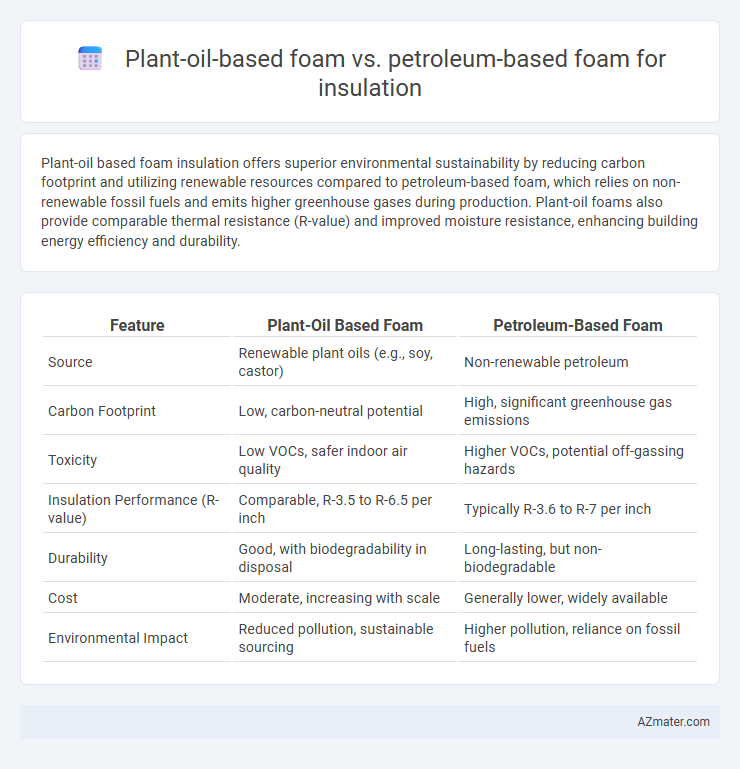Plant-oil based foam insulation offers superior environmental sustainability by reducing carbon footprint and utilizing renewable resources compared to petroleum-based foam, which relies on non-renewable fossil fuels and emits higher greenhouse gases during production. Plant-oil foams also provide comparable thermal resistance (R-value) and improved moisture resistance, enhancing building energy efficiency and durability.
Table of Comparison
| Feature | Plant-Oil Based Foam | Petroleum-Based Foam |
|---|---|---|
| Source | Renewable plant oils (e.g., soy, castor) | Non-renewable petroleum |
| Carbon Footprint | Low, carbon-neutral potential | High, significant greenhouse gas emissions |
| Toxicity | Low VOCs, safer indoor air quality | Higher VOCs, potential off-gassing hazards |
| Insulation Performance (R-value) | Comparable, R-3.5 to R-6.5 per inch | Typically R-3.6 to R-7 per inch |
| Durability | Good, with biodegradability in disposal | Long-lasting, but non-biodegradable |
| Cost | Moderate, increasing with scale | Generally lower, widely available |
| Environmental Impact | Reduced pollution, sustainable sourcing | Higher pollution, reliance on fossil fuels |
Introduction to Foam Insulation Materials
Plant-oil based foam insulation offers a sustainable alternative to traditional petroleum-based foam by utilizing renewable resources like soy, castor, or other vegetable oils, reducing dependency on fossil fuels. These bio-based foams provide comparable thermal resistance (R-values) and air-sealing properties while minimizing environmental impact and reducing volatile organic compound (VOC) emissions. In contrast, petroleum-based foams, primarily made from petrochemicals such as polyurethane, have long been standard for insulation due to their durability and cost-effectiveness but pose greater ecological and health concerns throughout their lifecycle.
What is Plant-Oil Based Foam?
Plant-oil based foam is an eco-friendly insulation material derived from renewable plant oils such as soybean, castor, or palm oil, which serve as natural polyol replacements in polyurethane foam production. This type of foam offers comparable thermal insulation properties to traditional petroleum-based foam while significantly reducing carbon footprint and reliance on non-renewable fossil fuels. Its biodegradability and reduced emissions during manufacturing make plant-oil based foam a sustainable alternative in energy-efficient building applications.
Overview of Petroleum-Based Foam
Petroleum-based foam insulation, primarily composed of polyurethane or polystyrene, offers high thermal resistance with R-values typically ranging from 5 to 7 per inch, making it a popular choice in residential and commercial construction. Derived from non-renewable fossil fuels, this foam provides excellent moisture resistance and structural support but raises environmental concerns due to its carbon footprint and challenges in biodegradability. Its widespread use is attributed to cost-effectiveness and established performance standards, despite growing interest in more sustainable alternatives like plant-oil based foams.
Key Ingredients and Manufacturing Processes
Plant-oil based foams use bio-derived ingredients such as soybean oil, castor oil, or palm oil, providing renewable and biodegradable components that reduce carbon footprint compared to petroleum-based foams made from polyols and isocyanates derived from fossil fuels. Manufacturing plant-oil foams involves polyol modification through transesterification or epoxidation to achieve suitable reactivity and mechanical properties, while petroleum-based foam production relies on petrochemical feedstocks and standardized polyol formulations for consistent performance. The use of bio-based polyols in plant-oil foam production also enables lower VOC emissions and improved sustainability throughout the insulation's lifecycle.
Thermal Performance Comparison
Plant-oil based foam insulation demonstrates comparable thermal performance to petroleum-based foam, with typical R-values ranging from 6.0 to 6.5 per inch, ensuring effective heat resistance. These bio-based foams reduce thermal bridging due to their closed-cell structure, providing consistent insulation in various climate conditions. Despite slightly higher initial costs, their superior environmental profile and ability to maintain long-term thermal stability position them as sustainable alternatives to traditional petroleum-based insulation foams.
Environmental Impact Assessment
Plant-oil based foam insulation significantly reduces carbon footprint by utilizing renewable biomass and emitting fewer volatile organic compounds (VOCs) compared to petroleum-based foam. Lifecycle analysis reveals that plant-oil foams have lower greenhouse gas emissions and contribute less to non-renewable resource depletion. Furthermore, biodegradability and reduced toxic residue from plant-oil foams enhance environmental sustainability while maintaining comparable thermal insulation performance.
Cost Analysis: Plant-Oil vs Petroleum Foams
Plant-oil based foam insulation typically incurs higher upfront costs compared to petroleum-based foam due to raw material expenses and production scale limitations. However, plant-oil foams offer potential long-term savings through enhanced sustainability credits and reduced environmental compliance costs. Petroleum-based foam remains cost-effective for large-scale projects but may face increasing price volatility linked to fossil fuel markets.
Durability and Longevity
Plant-oil based foam insulation offers enhanced resistance to moisture and microbial growth, contributing to improved durability compared to petroleum-based foam. Its natural composition reduces degradation over time, ensuring prolonged structural integrity and consistent insulation performance. Petroleum-based foam, while initially effective, tends to degrade faster under UV exposure and temperature fluctuations, resulting in shorter lifespan and maintenance needs.
Health and Safety Considerations
Plant-oil based foams for insulation offer lower levels of toxic chemical emissions, reducing indoor air pollution and the risk of respiratory issues compared to petroleum-based foams. These bio-based foams typically have fewer volatile organic compounds (VOCs) and hazardous flame retardants, enhancing overall occupant health and safety. Petroleum-based foams often release harmful gases like isocyanates during application and over time, posing greater risks of irritation, sensitization, and long-term health effects.
Future Trends in Foam Insulation Technology
Plant-oil based foam insulation is gaining momentum due to its renewable sourcing, lower carbon footprint, and potential for enhanced biodegradability compared to traditional petroleum-based foam. Advances in bio-based polyols and hybrid formulations are driving improvements in thermal performance, durability, and fire resistance, aligning with increasing regulatory pressures for sustainable building materials. Future trends indicate a shift towards fully bio-derived foams that integrate waste biomass and carbon capture technologies to create high-efficiency, circular insulation products.

Infographic: Plant-oil based foam vs Petroleum-based foam for Insulation
 azmater.com
azmater.com